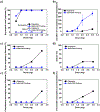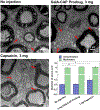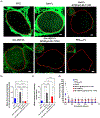Galacturonic acid-capsaicin prodrug for prolonged nociceptive-selective nerve blockade
- PMID: 38823584
- PMCID: PMC11209757
- DOI: 10.1016/j.jconrel.2024.05.046
Galacturonic acid-capsaicin prodrug for prolonged nociceptive-selective nerve blockade
Abstract
There is an urgent clinical need to develop nerve-blocking agents capable of inducing long duration sensory block without muscle weakness or paralysis to treat post-operative and chronic pain conditions. Here, we report a galacturonic acid-capsaicin (GalA-CAP) prodrug as an effective nociceptive-selective axon blocking agent. Capsaicin selectively acts on nociceptive signaling without motor nerve blockade or disruption of proprioception and touch sensation, and the galacturonic acid moiety enhance prodrug permeability across the restrictive peripheral nerve barriers (PNBs) via carrier-mediated transport by the facilitative glucose transporters (GLUTs). In addition, following prodrug transport across PNBs, the inactive prodrug is converted to active capsaicin through linker hydrolysis, leading to sustained drug release. A single injection of GalA-CAP prodrug at the sciatic nerves of rats led to nociceptive-selective nerve blockade lasting for 234 ± 37 h, which is a sufficient duration to address the most intense period of postsurgical pain. Furthermore, the prodrug markedly mitigated capsaicin-associated side effects, leading to a notable decrease in systemic toxicity, benign local tissue reactions, and diminished burning and irritant effects.
Keywords: Capsaicin; Galactose; Glucose transporters; Nociceptive-selective nerve blockade; Prodrug.
Copyright © 2024 Elsevier B.V. All rights reserved.
Conflict of interest statement
Declaration of competing interest The authors declare no conflict of interest.
Figures










Similar articles
-
Capsaicin-Loaded Melanin Nanoparticles for Long-Lasting Nociceptive-Selective Nerve Blockade.Langmuir. 2024 Nov 26;40(47):24751-24760. doi: 10.1021/acs.langmuir.4c01725. Epub 2024 Nov 14. Langmuir. 2024. PMID: 39541506 Free PMC article.
-
Topical capsaicin (high concentration) for chronic neuropathic pain in adults.Cochrane Database Syst Rev. 2017 Jan 13;1(1):CD007393. doi: 10.1002/14651858.CD007393.pub4. Cochrane Database Syst Rev. 2017. PMID: 28085183 Free PMC article.
-
Topical capsaicin (low concentration) for chronic neuropathic pain in adults.Cochrane Database Syst Rev. 2012 Sep 12;2012(9):CD010111. doi: 10.1002/14651858.CD010111. Cochrane Database Syst Rev. 2012. PMID: 22972149 Free PMC article.
-
Dexamethasone as an adjuvant to peripheral nerve block.Cochrane Database Syst Rev. 2017 Nov 9;11(11):CD011770. doi: 10.1002/14651858.CD011770.pub2. Cochrane Database Syst Rev. 2017. PMID: 29121400 Free PMC article.
-
Topical analgesics for acute and chronic pain in adults - an overview of Cochrane Reviews.Cochrane Database Syst Rev. 2017 May 12;5(5):CD008609. doi: 10.1002/14651858.CD008609.pub2. Cochrane Database Syst Rev. 2017. PMID: 28497473 Free PMC article.
Cited by
-
Exosomal Bupivacaine: Integrating Nerve Barrier Penetration Capability and Sustained Drug Release for Enhanced Potency in Peripheral Nerve Block and Reduced Toxicity.Adv Funct Mater. 2024 Oct 15;34(42):2406876. doi: 10.1002/adfm.202406876. Epub 2024 Jul 20. Adv Funct Mater. 2024. PMID: 40027274
-
Capsaicin-Loaded Melanin Nanoparticles for Long-Lasting Nociceptive-Selective Nerve Blockade.Langmuir. 2024 Nov 26;40(47):24751-24760. doi: 10.1021/acs.langmuir.4c01725. Epub 2024 Nov 14. Langmuir. 2024. PMID: 39541506 Free PMC article.
References
MeSH terms
Substances
Grants and funding
LinkOut - more resources
Full Text Sources
Miscellaneous

